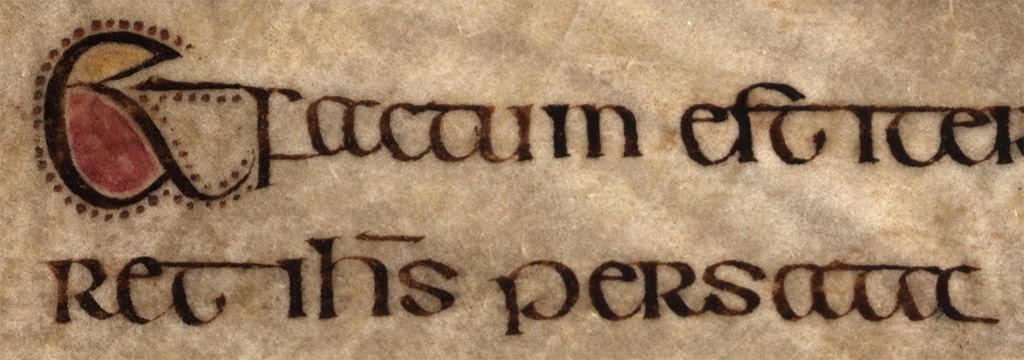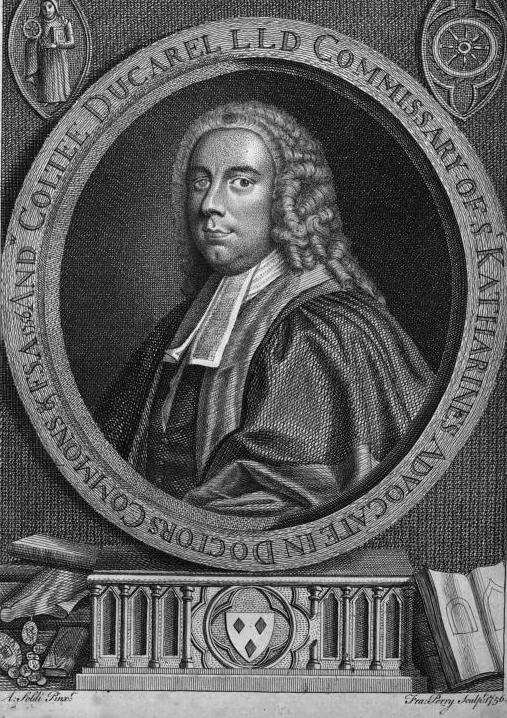|
Mac Durnan Gospels
The Mac Durnan Gospels or Book of Mac Durnan (London, Lambeth Palace MS 1370) is an illuminated manuscript Gospel book made in Ireland in the 9th or 10th century, a rather late example of Insular art. Unusually, it was in Anglo-Saxon England soon after it was written, and is now in the collection of Lambeth Palace Library in London.Keynes, "King Athelstan's books", p. 153. It contains the four gospels of Matthew, Mark, Luke and John, without the usual prefatory matter, and has a full-page evangelist portrait of each. There is an opening quasi-carpet page with the four evangelists' symbols in panels around a cross, and some elaborately decorated incipit pages. Manuscript history Information concerning the provenance and history of the manuscript comes from an alliterative Latin inscription which was added on folio 3v, possibly by Koenwald (d. 957/8), later bishop of Worcester. It suggests that the manuscript was written or commissioned by Máel Brigte mac Tornáin (d. 927), know ... [...More Info...] [...Related Items...] OR: [Wikipedia] [Google] [Baidu] |
Máel Brigte Mac Tornáin
Máel Brigte mac Tornáin, also known as Maelbrigte mac Durnan (died 22 February 927), was an Irish clergyman who served as Archbishop of Armagh, abbot of Armagh from 883 and, in his role as ''Coarb'' of Colum Cille, as the Abbot of Iona, non-resident from 891, holding both positions until his death. He is likely responsible for commissioning and may have worked on the ''Mac Durnan Gospels,'' an illuminated manuscript now held in the Lambeth Palace Library in London. Origins Máel Brigte was a distant member of the royal lineage of Colum Cille of the Uí Néill of Tyrconnell and a member of the Branches of the Cenél Conaill#Cenél mBógaine, Cenél mBógaine a sept of the Cenél Conaill. Two of his cousins were also members of the ''Celtic Christianity#Monasticism, paruchia'' of Colum Cille; Dubhthach mac Dubáin († 938), abbot of Raphoe, would succeed him as abbot of Iona and Caencomhrac († 929), abbot and bishop of Derry. Abbot of Armagh and Iona Máel Brigte began his ca ... [...More Info...] [...Related Items...] OR: [Wikipedia] [Google] [Baidu] |
Canterbury Cathedral
Canterbury Cathedral in Canterbury, Kent, is one of the oldest and most famous Christian structures in England. It forms part of a World Heritage Site. It is the cathedral of the Archbishop of Canterbury, currently Justin Welby, leader of the Church of England and symbolic leader of the worldwide Anglican Communion. Its formal title is the Cathedral and Metropolitical Church of Christ at Canterbury. Founded in 597, the cathedral was completely rebuilt between 1070 and 1077. The east end was greatly enlarged at the beginning of the 12th century and largely rebuilt in the Gothic style following a fire in 1174, with significant eastward extensions to accommodate the flow of pilgrims visiting the shrine of Thomas Becket, the archbishop who was murdered in the cathedral in 1170. The Norman nave and transepts survived until the late 14th century when they were demolished to make way for the present structures. Before the English Reformation the cathedral was part of a Benedictine ... [...More Info...] [...Related Items...] OR: [Wikipedia] [Google] [Baidu] |
Gospels Of Máel Brigte
The Gospels of Máel Brigte (British Library, Harley MS 1802, also known as the Armagh Gospels and the Marelbrid Gospels) is an illuminated Gospel Book, with glosses. It was created 1138, or 1139, by the scribe named Máel Brigte úa Máel Úanaig, in Armagh. The codex includes the Latin text of the Gospels, along with glosses and prefatory material. There are also several inscriptions in Irish. Composition There are 156 vellum folios along with 2 parchment and 2 paper flyleaves which are not counted in the official foliation. The leaves are 165 mm by 120 mm. The text is contained in area of 120 mm by 70 mm. The text is written in an Irish minuscule hand. The binding of red leather with gilt tooling is post-medieval. Contents In addition to the text of the Gospels, the manuscript includes several pieces of prefatory material. The Genealogy of Jesus found at the beginning of the Gospel of Matthew (Matthew 1:1-17) is treated as a separate work than the rest o ... [...More Info...] [...Related Items...] OR: [Wikipedia] [Google] [Baidu] |
Book Of Armagh
The ''Book of Armagh'' or Codex Ardmachanus (ar or 61) ( ga, Leabhar Ard Mhacha), also known as the ''Canon of Patrick'' and the ''Liber Ar(d)machanus'', is a 9th-century Irish illuminated manuscript written mainly in Latin. It is held by the Library of Trinity College Dublin (MS 52). The document is valuable for containing early texts relating to St Patrick and some of the oldest surviving specimens of Old Irish, and for being one of the earliest manuscripts produced by an insular church to contain a near complete copy of the New Testament. History The manuscript was once reputed to have belonged to St. Patrick and, at least in part, to be a product of his hand. Research has determined, however, that the earliest part of the manuscript was the work of a scribe named Ferdomnach of Armagh (died 845 or 846). Ferdomnach wrote the first part of the book in 807 or 808, for Patrick's heir (''comarba'') Torbach, abbot of Armagh. Two other scribes are known to have assisted him. The ... [...More Info...] [...Related Items...] OR: [Wikipedia] [Google] [Baidu] |
Echternach Gospels
The Echternach Gospels (Paris, Bib. N., MS. lat. 9389) were produced, presumably, at Lindisfarne Abbey in Northumbria around the year 690. This location was very significant for the production of Insular manuscripts, such as the Durham Gospels (ms. A.II.17) and the Lindisfarne Gospels (ms. Cotton Nero D. IV). The scribe of the Durham Gospels is believed to have created the Echternach Gospels as well.De Hamel, ''A History of Illuminated Manuscripts'', 32. The Echternach Gospels are now in the collection of France's Bibliothèque Nationale in Paris. This manuscript, and other such Hiberno-Saxon codices, were highly important instructional devices used in the Early Middle Ages primarily for conversion. The Echternach Gospels were probably taken by Willibrord, a Northumbrian missionary, to his newly founded Abbey of Echternach, now in Luxembourg, from which they are named. It is significant that this early Hiberno-Saxon manuscript should have been brought here because, with Willibr ... [...More Info...] [...Related Items...] OR: [Wikipedia] [Google] [Baidu] |
Insular Script
Insular script was a medieval script system originating from Ireland that spread to Anglo-Saxon England and continental Europe under the influence of Irish Christianity. Irish missionaries took the script to continental Europe, where they founded monasteries such as Bobbio. The scripts were also used in monasteries like Fulda, which were influenced by English missionaries. They are associated with Insular art, of which most surviving examples are illuminated manuscripts. It greatly influenced Irish orthography and modern Gaelic scripts in handwriting and typefaces. Insular script comprised a diverse family of scripts used for different functions. At the top of the hierarchy was the Insular half-uncial (or "Insular majuscule"), used for important documents and sacred text. The full uncial, in a version called "English uncial", was used in some English centres. Then "in descending order of formality and increased speed of writing" came "set minuscule", "cursive minuscule" and ... [...More Info...] [...Related Items...] OR: [Wikipedia] [Google] [Baidu] |
Andrew Coltee Ducarel
Andrew Coltée Ducarel (9 June 1713 – 29 May 1785), was an English antiquary, librarian, and archivist. He was also a lawyer practising civil law (a "civilian"), and a member of the College of Civilians. Early life and education Ducarel was born on 9 June 1713 in Paris. His parents, Jacques Coltée Ducarel (1680–1718) and Jeanne Crommelin (1690–1723), were Huguenots from Normandy.Myers 2008. Jacques was a banker and merchant, who achieved ennoblement in 1713 with the title Marquis de Chateau de Muids. He died in 1718, just as a new wave of Huguenot persecution was beginning, and in 1719 Jeanne fled with her three infant sons first to Amsterdam, and then, in 1721, to England. They settled in Greenwich, where Jeanne married her second husband, Jacques Girardot, another Huguenot. In 1728, Andrew was sent to be educated at Eton. The following year he suffered a serious accident there in which he lost one eye: he spent three months under the medical care of Sir Hans Sloane. I ... [...More Info...] [...Related Items...] OR: [Wikipedia] [Google] [Baidu] |
Lewis Morris (1701–1765)
Lewis Morris (2 March 1701 – 11 April 1765) was a Welsh hydrographer, antiquary, poet and lexicographer, the eldest of the Morris brothers of Anglesey. Lewis Morris was the eldest son of Morris ap Rhisiart Morris, a farmer, of Llanfihangel-Tre'r-Beirdd in Anglesey. His bardic name was Llewelyn Ddu o Fôn ("Black Llewelyn ewisof Anglesey"). The correspondence between him and his younger brothers is a valuable historical source. In 1751, he founded the Honourable Society of Cymmrodorion along with his brother Richard. Career as a cartographer Although there is no record of his having had any further education, Lewis Morris began his career as an estate-surveyor, and was employed by the Meyrick family of Bodorgan. He worked as a Customs official from 1729, and was later involved in the Cardiganshire mining industry. However, he is perhaps best known for his hydrographic surveys of the Welsh Coast. The idea for the survey probably arose while he was working as a Custom ... [...More Info...] [...Related Items...] OR: [Wikipedia] [Google] [Baidu] |
Corpus Christi College, Cambridge
Corpus Christi College (full name: "The College of Corpus Christi and the Blessed Virgin Mary", often shortened to "Corpus"), is a constituent college of the University of Cambridge. From the late 14th century through to the early 19th century it was also commonly known as St Benet's College. The college is notable as the only one founded by Cambridge townspeople: it was established in 1352 by the Guild of Corpus Christi and the Guild of the Blessed Virgin Mary, making it the sixth-oldest college in Cambridge. With around 250 undergraduates and 200 postgraduates, it also has the second smallest student body of the traditional colleges of the University, after Peterhouse. The College has traditionally been one of the more academically successful colleges in the University of Cambridge. In the unofficial Tompkins Table, which ranks the colleges by the class of degrees obtained by their undergraduates, in 2012 Corpus was in third position, with 32.4% of its undergraduates achievi ... [...More Info...] [...Related Items...] OR: [Wikipedia] [Google] [Baidu] |
Psalter
A psalter is a volume containing the Book of Psalms, often with other devotional material bound in as well, such as a liturgical calendar and litany of the Saints. Until the emergence of the book of hours in the Late Middle Ages, psalters were the books most widely owned by wealthy lay persons. They were commonly used for learning to read. Many Psalters were richly illuminated, and they include some of the most spectacular surviving examples of medieval book art. The English term (Old English , ) derives from Church Latin. The source term is la, psalterium, which is simply the name of the Book of Psalms (in secular Latin, it is the term for a stringed instrument, from grc, ψαλτήριον ''psalterion''). The Book of Psalms contains the bulk of the Divine Office of the Roman Catholic Church. The other books associated with it were the Lectionary, the Antiphonary, and Responsoriale, and the Hymnary. In Late Modern English, ''psalter'' has mostly ceased to refer to the ... [...More Info...] [...Related Items...] OR: [Wikipedia] [Google] [Baidu] |

.jpg)



